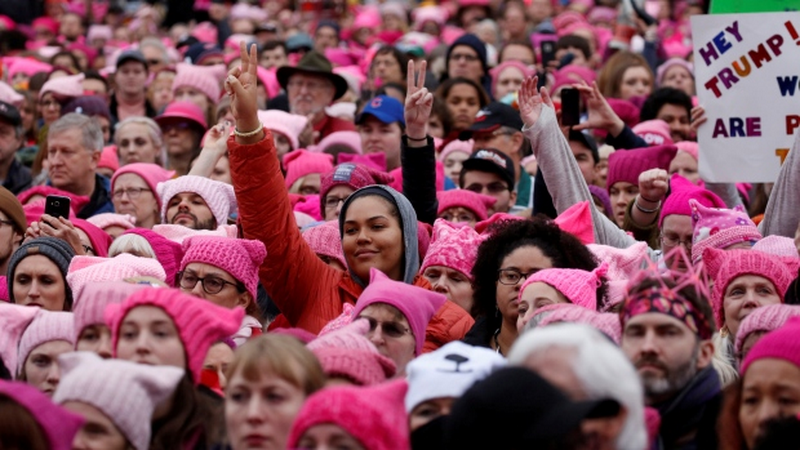Pussyhats reclaim femininity and empowerment
Pink, cat-eared hats dominated the Woman’s Marches, uniting women of all races and sexe
February 10, 2017
While the Women’s Marches that happened across the nation were inspirational themselves, the pink hats worn during the protests, dubbed “Pussyhats”, were particularly popular among women and young girls due to their symbolism and empowering backstory.
Created by the Pussyhat Project, the Pussyhats, which are pink with cat ears, were significant in that they encouraged the unity of women and girls displaying their passion for women’s rights.
“The hats are there to help show the capability of women around the world,” said sophomore Ella Schotz, who attended the Women’s March alongside her sister.
“Banding together thousands of women marching for their beliefs in over 600 locations by wearing identical hats — that’s pretty insane,” Schotz said.
Sophomore Michelle Capone was also amazed by the solidarity of women. “Seeing women of all different colors come together was extraordinary for me,” said Capone.
The Pussyhats are far from ordinary hats that just happened to be worn at the marches. Many of the small details of the hats were chosen specifically to be symbolic of feminine power, including the color of the yarn.
The color pink, traditionally thought of as feminine, was purposefully picked for the hats, showing that pink can represent strength.
“There’s a huge industry surrounding the color pink for little girls, it’s this ‘Disney Princess’ culture,” said art teacher and Feminism Club sponsor Gardiner Funo.
“The pink hats embrace the color as something that is strong, rather than being weak, soft, and just pretty.”
The official website for the Pussyhat Project similarly explains why they used pink. The founders believe that the qualities represented by pink, such as compassion and love, have been considered as weak, when those qualities are actually strong.
Schotz agreed with the significance of the use of the color. “Pink is typically a feminine color. This shows that you can be both feminine and a feminist at the same time,” Schotz said.
The Pussyhats were knit by women, for women, as opposed to being bought in mass quantities. Since the items are handcrafted, the process of knitting shows a certain level of effort and care.
Junior and head of Knitting Club Meghan Rittmanic acknowledges the significance of dedicating oneself to knitting.
“It shows you put effort into the movement – into what you’re doing – and it shows the community effort,” said Rittmanic.
“The reason they weren’t store-bought is to show a more personal element, especially since there are different styles and designs that you can make the hats.”
In fact, the hobby of knitting is what led Krista Suh and Jayna Zweiman to start the Pussyhat Project.
The Pussyhat Project combined Suh and Zweiman’s knowledge of knitting with their desire to make a statement about women’s rights at the march.
According to the website, the aim was to “Provide the people of the Women’s March on Washington D.C. a means to make a collective visual statement and provide people who cannot physically be [present] a way to represent themselves and support women’s rights.”
The idea for naming them “Pussyhats” partially stemmed from recent political events, including the allegations against President Trump that he would “grab women by their pussy.”
However, the name mostly came from the general desire of Suh and Zweiman to reclaim the term from being crude to empowering.
Junior Jack Mosele noticed how the female anatomy was a main symbol at the Women’s March.
“Though this isn’t a symbol for all women worldwide, such as non- cisgender persons, many people associated the hats with the popular phrase ‘Pussy Power’,” said Mosele.
“The hats spread the idea of ‘Pussy Power’ and equality of the sexes.”
Despite the surge of feminine pride that the pussyhats and marches created, the feminist movement still has progress to make in terms of being inclusive of all kinds of people.
“It showed how far feminism still has to go,” said Capone. “There was cis-sexism and white feminism in the march, despite the march being organized by women of color. Feminism-wise, I thought that we could do more for women of color and LGBTQ women.”
The future of feminism lies not just in the hands of current women’s rights activists, but also within the young women and girls of modern society who are interested in standing up for feminism.
Junior Olivia Schotz has suggestions for how younger generations of women can speak up.
“A good way is joining clubs and organizations that advocate for this issue,” said Schotz. “Being a part of a group with other women and girls can help [each girl] feel more impactful.”
Despite the current threats to feminism, the Pussyhats, arguably, still helped in turning thousands of passionate women into one loud voice.
“It united the women attending and let them know that we are stronger together,” explained sophomore Emma Citow, “and a force to be reckoned with.”














































